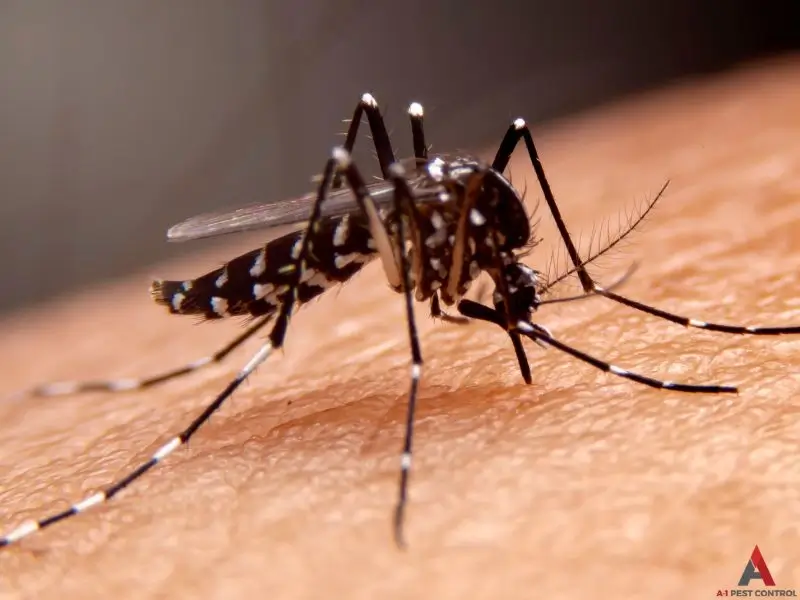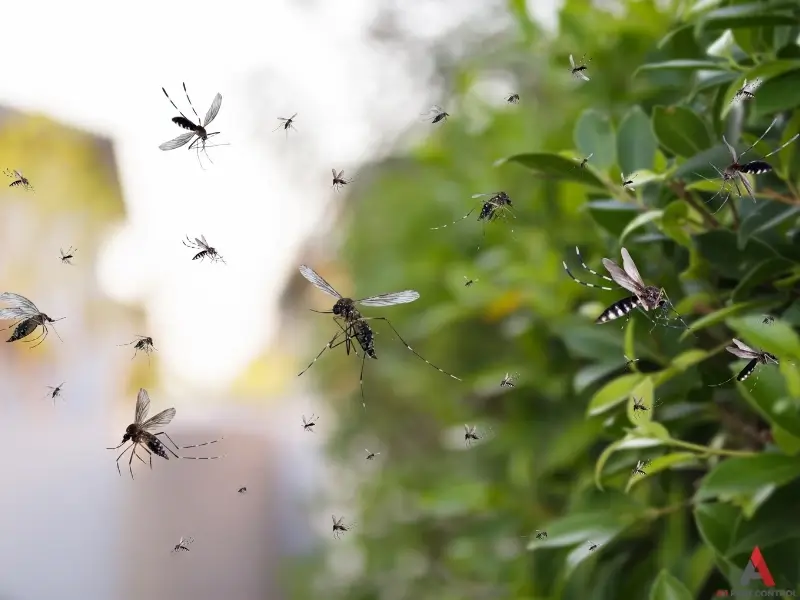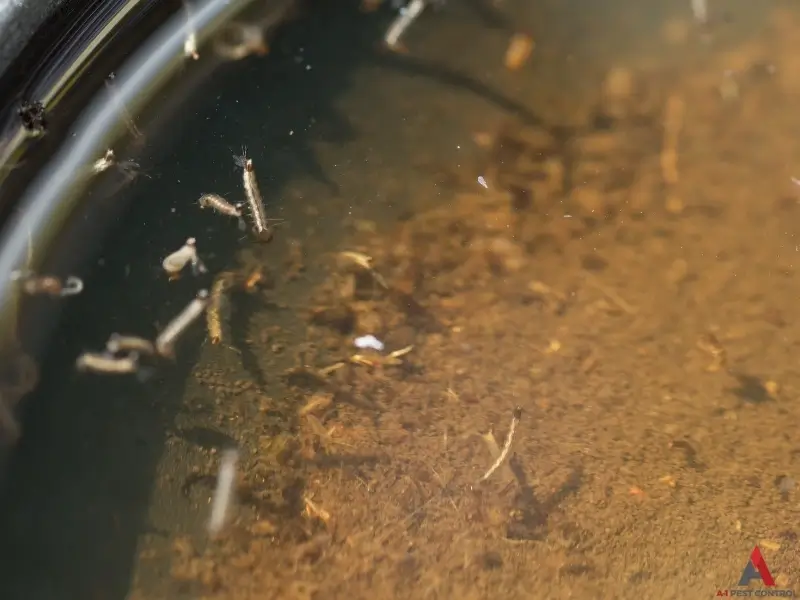
Asian Tiger Mosquito Identification Guide
Table of Contents
What is the Asian Tiger Mosquito?

Overview of Aedes albopictus
The Asian tiger mosquito (Aedes albopictus) is a highly invasive mosquito species originally native to Southeast Asia. Earning its nickname from its bold striped appearance and aggressive biting behavior, this mosquito has become a major concern in the U.S. due to its adaptability and role in spreading dangerous diseases.
Why This Mosquito is a Concern
Unlike many mosquitoes that are active at dawn or dusk, the Asian tiger mosquito bites aggressively during the daytime. It’s not only a serious nuisance for homeowners and outdoor enthusiasts—it’s also a potential vector capable of transmitting several harmful viruses to humans and animals.
Common Locations & Habitats
Asian tiger mosquitoes are most commonly found in warm, humid climates and are particularly active during the warmer months. They’re adept at breeding in small amounts of standing water, which makes the following spots especially prone to the appearance of the Asian tiger mosquito:
- Residential yards
- Gardens
- City parks ideal
Invasive Species Impact
The Asian tiger mosquito (Aedes albopictus) is an invasive species that has significant impacts on public health, ecosystems, and the economy. As a vector of various diseases, including dengue fever, chikungunya, and yellow fever, the Asian tiger mosquito poses a significant threat to human health. Its ability to adapt to new environments and aggressive feeding behavior make it a formidable invasive species.

The Asian tiger mosquito can also outcompete native mosquito species for resources, leading to a decline in native populations. Plus, its feeding behavior can alter the behavior of other animals in the ecosystem, causing shifts in population dynamics.
How to Identify an Asian Tiger Mosquito
Physical Characteristics
Identifying an Asian tiger mosquito starts with recognizing its unique markings:
- Black body with distinctive white stripes
- A single white stripe running down the center of its thorax
- White bands on the legs
These bold, contrasting colors set it apart from more common brown or gray mosquitoes.
Size & Appearance Compared to Other Mosquitoes
The Asian tiger mosquito is slightly smaller than many other mosquito species, measuring about 2 to 10 mm in length. Despite its small size, its dramatic coloration and daytime activity make it easier to spot. Its wings and body are also narrower and more slender compared to other local mosquito varieties.
Differences Between Asian Tiger and Yellow Fever Mosquito
While both species are capable disease carriers, they can be distinguished by a few key differences between the Yellow Fever Mosquito (Aedes aegypti) and Aedes albopictus mosquito:
- Aedes aegypti has lyre-shaped white markings on its thorax instead of a single stripe.
- Aedes aegypti is more commonly found indoors, whereas Aedes albopictus prefers outdoor, shaded areas.
- The Asian tiger mosquito tends to be more cold-tolerant and is rapidly expanding its range across the U.S.
Life Cycle of the Asian Tiger Mosquito
The life cycle of the Asian tiger mosquito consists of four stages: egg, larva, pupa, and adult. Understanding these stages is crucial for effective mosquito control and disease prevention.
Stages of Development

- Egg Stage: Female tiger mosquitoes lay their eggs in standing water, often in containers like flower pots, bird baths, or clogged roof gutters. The tiger mosquito eggs are resilient and can survive dry conditions for extended periods. Once rehydrated, the eggs hatch into larvae within 48 hours.
- Larval Stage: Known as wrigglers, the tiger mosquito larvae feed on small organisms and organic matter in the water. They undergo four instars, molting their skin as they grow. This stage lasts around 5-7 days, depending on environmental conditions.
3. Pupal Stage: The larvae transform into pupae, also known as tumblers. This non-feeding stage lasts around 2-3 days, during which the pupae rest at the water surface, preparing to emerge as adult mosquitoes.
4. Adult Stage: Adult mosquitoes emerge from the pupae and begin their search for a blood meal. This stage is the longest, lasting around 2-4 weeks. Adult tiger mosquitoes are responsible for biting humans and animals, spreading diseases, and continuing the reproductive cycle.
Factors Influencing Growth
Several factors influence the growth and development of the Asian tiger mosquito:
- Temperature: The Asian tiger mosquito thrives in temperatures between 64°F and 90°F (18°C and 32°C). Warmer temperatures accelerate the life cycle, leading to faster development from egg to adult.
- Humidity: High humidity is essential for the mosquito’s survival, particularly during the larval stage. Humid conditions help maintain the standing water necessary for larval development.
- Water Quality: The mosquito can tolerate a wide range of water quality but prefers standing water with high levels of organic matter. Such conditions provide ample food for the larvae.
- Food Availability: Larvae feed on small organisms and organic matter, while adult mosquitoes feed on nectar and blood. Adequate food sources are crucial for the mosquito’s growth and reproduction.
- Predation: Natural predators, including fish, frogs, and other insects, can impact mosquito populations. However, the Asian tiger mosquito’s adaptability often allows it to thrive despite predation.
Understanding the life cycle and factors influencing the growth of the Asian tiger mosquito is crucial for developing effective control measures and preventing the spread of diseases.
Behavior & Habitat
Where They Breed & Live
Asian tiger mosquitoes are highly adaptable and thrive in environments that many other mosquito species struggle to colonize. Their ability to utilize small and often overlooked water sources makes them especially challenging to control.
They prefer:
- Warm, humid climates: These conditions accelerate their life cycle, allowing eggs to hatch and mature into adults within days. As climate change continues to expand warmer zones, the Asian tiger mosquito’s range is growing rapidly across the United States.
- Small containers with standing water: Unlike mosquitoes that require large bodies of water, Aedes albopictus can lay eggs in just a bottle cap’s worth of water. Common breeding spots include:
- Flowerpots: Especially ones with saucers that collect rainwater.
- Birdbaths: If not cleaned or emptied regularly, these provide an ideal, shaded breeding site.
- Old tires: Often left outdoors, tires easily trap rainwater and can become long-term mosquito nurseries.
- Clogged gutters: When filled with leaves and debris, gutters retain stagnant water and become breeding grounds tucked away from view.
- Overgrown Shrubs: Mosquitos breed in shaded areas, and overgrown shrubs are a perfect haven for reproduction.
- Artificial containers: These mosquitoes lay their eggs in various water-filled artificial containers, such as old tires and buckets, emphasizing the importance of these breeding sites in facilitating the survival and proliferation of mosquito populations.
These areas are especially dangerous because they’re close to human activity, increasing the chances of bites and disease transmission. Eggs laid in these containers are resilient—they can survive dry conditions for weeks or even months, hatching only when rehydrated.
Active Times & Feeding Habits
Unlike most mosquitoes that tend to bite around dawn and dusk, Asian tiger mosquitoes have earned a reputation for being aggressive daytime biters, strongly attracted to humans for blood meals, which makes them particularly troublesome for homeowners, gardeners, and anyone enjoying time outdoors during daylight hours.
When it comes to choosing a host, Aedes albopictus is not picky. While many mosquito species prefer specific types of blood meals, the Asian tiger mosquito readily feeds on a variety of mammals and birds. This broad feeding behavior increases its potential to spread diseases between animals and humans, a factor that makes it a major public health concern.
These mosquitoes prefer cool, sheltered areas during the heat of the day. You’ll most often find them hiding and resting in:
- Shrubs
- Overgrown hedges
- Tall grass
- Undersides of leaves
- Around the perimeter of homes in shaded landscaping
Because they spend much of their time in close proximity to spaces that people frequent, are especially hard to avoid and more likely to enter homes or hover around patios, decks, and porches.
Health Risks Associated with the Asian Tiger Mosquito
The Asian tiger mosquito (Aedes albopictus) is not just a nuisance—it’s a major public health threat due to its ability to transmit several serious viral illnesses. Unlike some other mosquito species that carry only one or two diseases, the Asian tiger mosquito is a known vector for multiple viruses that affect both humans and animals. Below is a breakdown of the most significant threats associated with this mosquito:
Diseases They Can Transmit
Zika Virus
Originally identified in Africa, Zika gained international attention during the 2015–2016 outbreaks. While often mild in adults, Zika can cause serious birth defects, including microcephaly, when contracted during pregnancy. It is primarily spread through mosquito bites but can also be transmitted sexually and through blood transfusions.
Dengue Fever
Common in tropical and subtropical climates, Dengue can cause severe flu-like symptoms and, in rare cases, progress to Dengue Hemorrhagic Fever, which can be fatal. The virus has four distinct strains, meaning a person can be infected multiple times with increasing severity after each infection.
Chikungunya Virus
Known for its debilitating joint pain, Chikungunya can make everyday movements painful and difficult. While rarely fatal, symptoms can last for weeks or even months, and in some cases, joint pain may become chronic. It spreads quickly in communities and has led to widespread outbreaks in recent years.
West Nile Virus
West Nile is the most common mosquito-borne virus in the continental United States. Many people infected with West Nile show no symptoms, but for some, it can lead to serious neurological complications, including encephalitis and meningitis. Older adults and immunocompromised individuals are at greater risk of severe outcomes.
How These Diseases Spread
Transmission occurs when an infected mosquito bites a human or animal. Because Aedes albopictus feeds on multiple hosts, including domestic and wild animals, it can easily spread viruses across populations, making early prevention critical.
Need Help Controlling Mosquitoes? Contact A-1 Pest Control Today!
For professional mosquito control, call A-1 Pest Control at 828-481-9140 or fill out the form below to get a free inspection.


